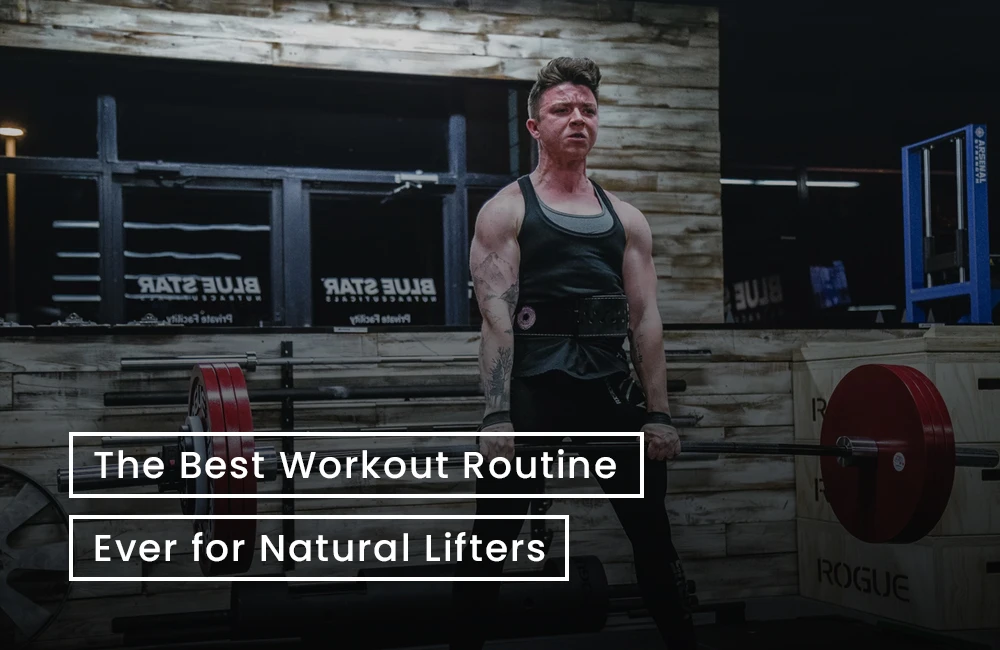Table of Contents
DO NOT TRAIN LIKE DRUG-ADDED GENETIC FREAK
You can’t train like an augmented bodybuilder or action movie star if you’re a natural lifter. And you can’t train like a genetic freak if you have ordinary genetics. It’s easy to mimic the training routines of individuals we like, but always pursuing the next “star program” will get you nowhere.
So, how should natural lifters exercise to achieve the greatest results? It goes like this:
- Six days a week, perform a push/pull split (or push+quads/pull+hamstrings).
- With that level of frequency, you only need one exercise per muscle group and three total sets: two sets of moderate-intensity to warm up, followed by one hard set.
- On each of the three weekly sessions, try out new strategies and exercises.
The goal of training is to improve performance and health. However, when you train like a drug-enhanced genetic freak, it backfires in the long run. Some people are born with an innate ability for endurance or strength but most can increase their abilities by using smarter methods that promote better results over time.
Don’t be fooled into thinking your genetics make you destined for greatness – they don’t! Get started on your journey today by learning how to take steps toward success instead of huge leaps towards disaster. You’ll see improved performance and less wear & tear on your body along the way too! What’s holding you back from starting?
The Most Common Natty Error
Those who do not utilize performance-boosting medications frequently make the error of performing too much volume. The goal of muscle-building training is to stimulate protein synthesis. There’s no use in punishing a muscle after it’s been stimulated since it won’t develop anymore. It may even shrink in size!
The key to growth is a large disparity between protein synthesis (muscle building) and protein breakdown (muscle breakdown) (mobilizing amino acids from muscles for energy). The more you exercise, the more protein is broken down. That’s something you don’t want to happen.
This is a mistake that can be easily corrected by decreasing the volume of your training and focusing on intensity. You will still get great results, and you won’t have to worry about overtraining or injury. So, make sure that you are lifting heavy weights and doing enough sets to fatigue the muscle – but no more. Are you making this common natty mistake?
The King of Frequency is
Frequency is the key to maximizing growth. This is true not just for how often you exercise a muscle each week, but also for how many training sessions you have every week.
Because the actual training session provides the stimulus that triggers protein synthesis, frequency is critical for the natural lifter. To put it another way, the workout triggers anabolic mode, however the augmented bodybuilder doesn’t need to utilize the workout as a trigger. The improved lifter works in anabolic mode around the clock!
As a result, the more you exercise, the longer your body stays in an anabolic condition and the more muscle you gain. But keep in mind that frequency and volume are inversely proportional. When you’re natural, you won’t be able to execute a high volume of labor if you exercise frequently.
Frequency is more effective than volume. For a natural trainee, hitting a muscle three times per week is the ideal frequency (with a low volume to compensate for the increase in frequency). Train six days a week, targeting half of your body with short, low-volume sessions. That’s the only way to achieve the best frequency without releasing too much cortisol.
The Split in Training
The push/pull split is the ideal physical and psychological divide:
MUSCLES PULLING
- Hamstrings
- Back
- Biceps
Muscle pulling is a great way to increase strength and power. This type of training has been used by athletes for years, but you don’t have to be an Olympian to see results. If you’re looking to get stronger, improve your performance, or simply feel better in your skin, adding muscles pulling exercises into your routine is a great place to start.
PUSHING MUSCLES
- Quads
- Pecs
- Delts
- Triceps
Each push or pull workout will include four movements, one for each muscle group (two for the back because it is made up of so many muscles).
To increase muscle mass, you need to put stress on the muscles by pushing them beyond their normal range of motion. This can be done with weights or by using your body weight as resistance. The key is to push yourself hard enough that you feel the burn in the muscles and then give them time to recover so they can grow stronger.
PULL WORKOUT (WORKOUT A)
- Stretching your hamstrings
- Exercising the lats/back-width
- Exercise for the rhomboids and posterior deltoids
- Biceps workout
PULL is all about engaging your entire body, challenging yourself and having fun. We know you’ll be getting a great workout – but what else can happen with just 15 minutes? You might find that it improves mood or cognitive function, increases the sense of self-efficacy, enhances social behaviour and even reduces symptoms associated with depression.
PUSH WORKOUT (WORKOUT B)
- Quadrilateral exercise
- Pec workout
- Exercising the Delt
- Triceps workout
The PUSH workout is an intense full-body strength training routine that takes just 10 minutes to complete. This workout can be done at home with no equipment, making it a great option for busy people who don’t have time to go to the gym.
Three times a week, you complete three pull exercises and three push workouts, each with a different exercise. While you can do any exercise you choose, I like to do two multi-joint exercises and one isolated exercise whenever feasible.
For example, Romanian deadlifts may be the first hamstring session of the week, while lying leg curls might be the second. Glute ham raises might be the isolated technique for the third hamstring workout of the week.
See also Proper HIIT Workouts on a Treadmill
How many sets should I do and in what order should I do them?
For each exercise, you will perform two preparatory sets. These are the sets when you gain a feel for the weight and choose the training weight for the work session (s). It also increases the mind-muscle link by bringing blood into the muscle.
These aren’t your average warm-ups. They’re done with weights that are near to your working set weight, or you can use the same weight as your working sets but complete fewer reps; in general, your degree of effort on these two sets should be about 7 out of 10.
After that, you’ll finish one last work set. This will necessitate the employment of a unique technique/method (described below) and must be completed to technical failure (but not to the point of cheating to get the weight up). Only the third and last set of each exercise will be done using these specific techniques:
1. REST/PAUSE HEAVY DOUBLE
- Choose a weight that will allow you to complete 4-6 repetitions.
- Do your 4-6 hard reps, rest 10-15 seconds, then repeat with another 2-3 reps, rest 10-15 seconds, and aim to gain an extra 1-2 reps.
- The same weight should be used every time. This particular technique/method is only used once.
The HEAVY DOUBLE REST/PAUSE technique is a great way to increase your one-rep max and get you stronger in the process. After picking a weight that allows you around 4-6 reps, do your 4-6 hard reps, rest 10-15 seconds, then try to get an additional 1-2 more reps. Rest again for another 10-15 seconds before doing 2 or 3 more hard repetitions with this same weight.
This will help build strength while minimizing injury risk by allowing muscles time to recover between sets of heavy lifting. Remember not to go too heavy on this method because it’s only done once per workout session! You can use this special technique after completing your regular training sessions as well.
2. MTOR ACTIVATION TO THE MAXIMUM
The secret here is how you do each rep: the eccentric (negative) and loaded stretching contractions are the ones that boost mTor activation the greatest. As a result, with this strategy, you’ll perform the following:
- Lower the weight for 5 seconds while tensing/flexing the target muscle as hard as possible.
- For each rep, hold the full stretch posture for 2 seconds.
- Do 6-8 reps like this, holding the stretch posture for as long as you can tolerate on the last rep. You just execute one set of this unique approach or procedure.
So, if you’re looking to increase muscle growth and mTOR activation, make sure that you are accentuating the eccentric (negative) portion of each rep and using loaded stretches. These techniques will help to ensure that your muscles are working hard throughout the entire range of motion and will result in maximum mTOR activation.
3. DROP SET 6-8-10
- Begin with a weight that you can lift for 6 repetitions.
- Reduce the weight by 25-40% (depending on the activity) and complete 8 repetitions with that new weight.
- Drop the weight by another 25-40% and do 10 additional repetitions.
- Between each phase of the drop set, take as little time as possible to rest. This unique technique/method should only be used once.
If you’re looking to take your workout (or strength training in general) up a notch, give the 6-8-10 drop set technique a try. This unique method is sure to challenge and fatigue your muscles like never before. Just be warned – it’s not for the faint of heart!
See also Battle Rope, Jump Rope, and Other Rope Workouts
The Program: How to Finally Lose Weight and Keep It Off
This program is out of the ordinary, at least in comparison to most modern-day regimens, but how has traditionally worked for you thus far?
The Program is unconventional, at least when compared to most modern-day plans. It’s worth it for those who want more control over their life and the ability to take on massive personal challenges that will push them beyond what they think they can do. If you like a challenge and don’t mind taking risks, then this program might be perfect for you!
MONDAY – A1 WORKOUT
- 2 sets of anadrol 6 Romanian Deadlifts and one all-out heavy double rest/pause set
- 2 sets of 6 and one all-out heavy double rest/pause set for pronated lat pulldowns or pull-ups
- 2 sets of 8 and one 6-8-10 drop set for bent-over laterals
- 2 sets of 6 standing barbell curls and one all-out heavy double rest/pause set
WORKOUT B1 TUESDAY
- 2 sets of 6 front squats, with one all-out heavy double rest/pause set
- 2 sets of 6 reps of bench press, with one all-out heavy double rest/pause set
- 2 sets of 6 dumbbell lateral raises and one 6-8-10 drop set
- Triceps Extensions with Lying Dumbbells: 2 sets of 6 and one set of maximal mTOR activation
WORKOUT A2 ON WEDNESDAY
- 2 sets of 6 lying leg curls and one 6-8-10 drop set
- 2 sets of 6 straight-arm pulldowns or dumbbell pullovers, with one session of maximal mTOR activation
- 2 sets of 8 and one all-out heavy double rest/pause set for a pronated chest-supported row
- Preacher Curl: two sets of six, plus one set of maximal mTOR activation
WORKOUT B2 ON THURSDAY
- 2 sets of 6 leg extensions and one 6-8-10 drop set
- 2 sets of 6 and one maximum mTor activation set (Pec Deck or Cable Crossover)
- 2 sets of 6 and one all-out heavy double rest/pause set for Military Press or Dumbbell Shoulder Press
- 2 sets of 6 and one all-out heavy double rest/pause set for Close-Grip Decline Bench Press or Dip
WORKOUT A3 ON FRIDAY
- 2 sets of 6 and one set of maximal mTOR activation for Glute Ham Raise or Reverse Hyper:
- 2 sets of 6 and one 6-8-10 drop set for supinated lat pulldowns
- 2 sets of 6 Neutral-Grip Cable Seated Row and one maximum mTor activation set
- 2 sets of 6 dumbbell hammer curls and one 6-8-10 drop set
WORKOUT B3 ON SATURDAY
- 2 sets of 6 and one maximal mTor activation session on the hack squat machine or leg press
- 2 sets of 6 and one 6-8-10 drop set for incline bench press or incline dumbbell press
- 2 sets of 6 dumbbell front raises on an incline bench, plus one session of maximal mTOR activation
- 2 sets of 6 and one 6-8-10 drop set for the rope triceps extension
See also Spartan Workout: Preparing for Spartan Races
Here are the most commonly asked questions about
For natural lifters, what is the optimal workout split?
There’s no one-size-fits-all answer to this question. The optimal workout split for natural lifters will depend on their goals, training age, and experience level. For example, if your goal is to increase muscle size or improve performance in a particular sport without gaining too much fat along the way, then you should focus more of your time lifting heavy weights with lower repetitions while also practising sports specific movements like sprints and agility drills.
It’s no secret that bodybuilders are not the only ones who can benefit from a well-designed workout routine. You don’t need to have any of your muscles injected with steroids, or use anabolic drugs to see some results.

What are the best ways for natural lifters to prepare for the competition?
The best way to prepare for a competition is by training with intensity and purpose. We know that you can’t get the same results from lifting weights in your living room, but there are still ways to simulate certain aspects of being on stage or at an event during training. For example, if you’re going up against lifters who have been using performance-enhancing drugs (PEDs) then you must train as though they were too–even just for a month before the contest date. This will help even out any advantages they may have over you when it comes time to compete! If PURPOSEFUL TRAINING isn’t enough, we also offer pre-workout supplements.
If you’re a natural lifter, the best way to prepare for competition is by stepping up your weight training. Building muscle and gaining strength will not only make it easier to add more reps with heavier weights in meet day prep but also help give you the edge over competitors who rely on drugs or performance enhancers.
Do naturals benefit from split routines?
Split routines are a popular workout regimen among those who want to maximize their time and effort at the gym. For this type of routine to work, you need to have enough energy throughout the day in order not to crash after only working out intensely for 30 minutes or so.
This is where natural bodybuilders may fall short since they often experience more fatigue than someone with a different diet plan. Training your muscles three days per week will likely be too much stimulus on your system even if you eat a high protein diet that aids muscle recovery from exercise-induced damage. Your best bet is probably going back down to two training sessions per week until you build up some stamina again then gradually increasing it as needed over time.”
Which muscle-building split is best?
With so many different variations of exercise programs out there, it can be difficult to know which one is best. That’s why we have tried them all and ranked the top three below for you! The conclusion should summarize your findings in a concise manner that leaves readers wanting more while also providing an actionable call-to-action. It’s important to provide some details about what makes each split plan unique or better than others.
Because all connected muscle groups are exercised in the same session, the push/pull/legs split is perhaps the most effective workout split. This means you receive the most movement overlap possible within the same session, and the muscle groups being worked benefit from it overall.
Workouts for quick natural increases in natural bodybuilding
Anyone who is looking to make a quick change in their body without taking steroids should consider these workouts. The use of drugs can lead to irreversible side effects, while the natural methods outlined here will only show benefits for your health and fitness goals. You’ll notice changes within weeks!
See also WHAT IS BLOOD FLOW RESTRICTION?




